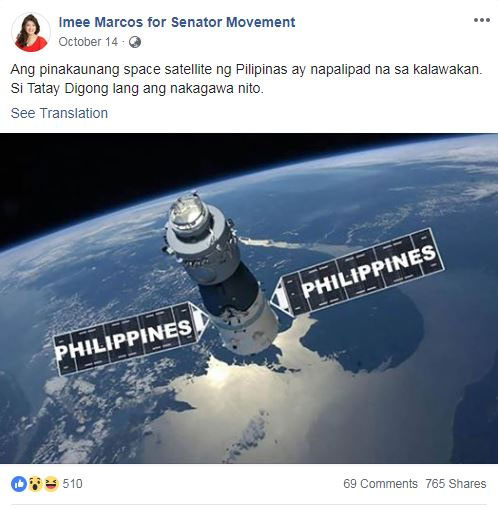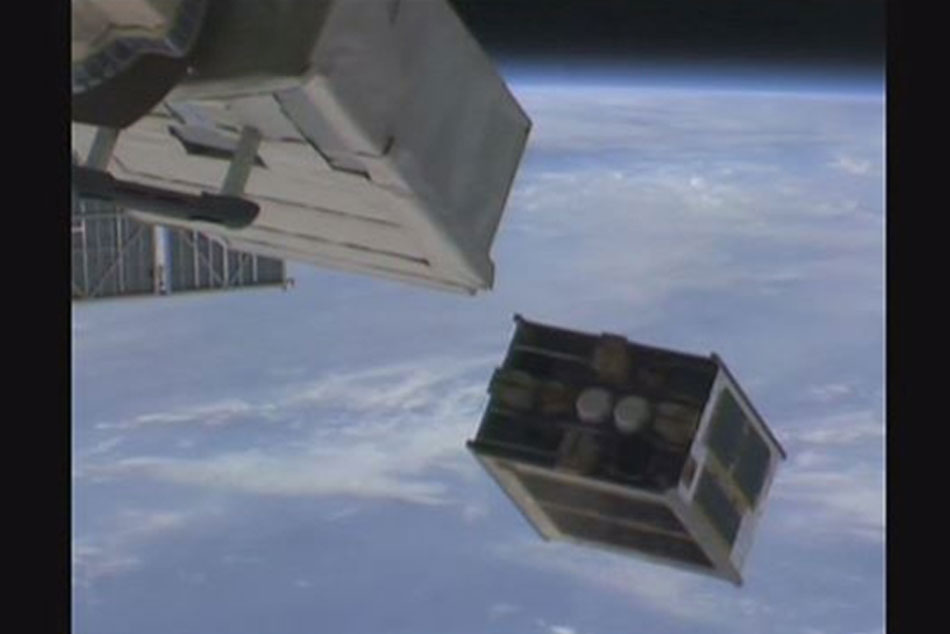FACT CHECK: No, this is not a photo of the Philippines' first space satellite | ABS-CBN
ADVERTISEMENT

Welcome, Kapamilya! We use cookies to improve your browsing experience. Continuing to use this site means you agree to our use of cookies. Tell me more!
FACT CHECK: No, this is not a photo of the Philippines' first space satellite
FACT CHECK: No, this is not a photo of the Philippines' first space satellite
Agence France-Presse
Published Nov 16, 2018 05:19 PM PHT
|
Updated Nov 16, 2018 08:56 PM PHT
A Facebook post shares a photo that it claims shows the Philippines’ first satellite in space. The Philippines' Department of Science and Technology said it was not a photograph of the country’s first satellite. The image has been widely used online for years in reports on China’s Tiangong-1 space station.
A Facebook post shares a photo that it claims shows the Philippines’ first satellite in space. The Philippines' Department of Science and Technology said it was not a photograph of the country’s first satellite. The image has been widely used online for years in reports on China’s Tiangong-1 space station.
The October 14 post contains a photo of the purported satellite, which has “PHILIPPINES” written on the panels that extend from its body.
The October 14 post contains a photo of the purported satellite, which has “PHILIPPINES” written on the panels that extend from its body.
Here’s a screenshot of the post:
Here’s a screenshot of the post:
The post, when translated to English, says: “This is the very first space satellite of the Philippines that has been sent to space. Only Digong our father was able to do this”.
The post, when translated to English, says: “This is the very first space satellite of the Philippines that has been sent to space. Only Digong our father was able to do this”.
ADVERTISEMENT
“Digong” is one of the nicknames for Philippine President Rodrigo Duterte.
“Digong” is one of the nicknames for Philippine President Rodrigo Duterte.
The Philippines has a satellite program and it has sent at least two orbiters into space -- the first in 2016 and the second in October 2018.
The Philippines has a satellite program and it has sent at least two orbiters into space -- the first in 2016 and the second in October 2018.
However, one of the program's scientists told AFP that the image in the Facebook post does not show the Philippines’ first satellite.
However, one of the program's scientists told AFP that the image in the Facebook post does not show the Philippines’ first satellite.
“No, it's not,” said Gay Jane Perez, head of the program's remote sensing and product development component.
“No, it's not,” said Gay Jane Perez, head of the program's remote sensing and product development component.
She said the Philippines’ first satellite was Diwata-1, which was launched into space in April 2016.
She said the Philippines’ first satellite was Diwata-1, which was launched into space in April 2016.
ADVERTISEMENT
Duterte became president in June 2016, after winning a landslide victory the prior month.
Duterte became president in June 2016, after winning a landslide victory the prior month.
This picture from the Japan Aerospace Exploration Agency shows Diwata-1:
This picture from the Japan Aerospace Exploration Agency shows Diwata-1:
A reverse image search revealed the photo in the Facebook post has been used repeatedly in reports dating back to early 2016 about China’s Tiangong-1 space lab.
A reverse image search revealed the photo in the Facebook post has been used repeatedly in reports dating back to early 2016 about China’s Tiangong-1 space lab.
The image, which is credited to China’s space agency CMSE, was used in mainstream reports like this one in the Guardian and this one on ABC Australia.
The image, which is credited to China’s space agency CMSE, was used in mainstream reports like this one in the Guardian and this one on ABC Australia.
The misleading post was published by a Facebook page that supports Imee Marcos, the daughter of former Philippine dictator Ferdinand Marcos. The Marcos family is Duterte’s ally.
The misleading post was published by a Facebook page that supports Imee Marcos, the daughter of former Philippine dictator Ferdinand Marcos. The Marcos family is Duterte’s ally.
ADVERTISEMENT
The post has been shared more than 700 times.
The post has been shared more than 700 times.
Read More:
DOST
space satellite
Diwata-1
fake news
fact check
Imee Marcos
Rodrigo Duterte
Digong
social media
ADVERTISEMENT
ADVERTISEMENT




